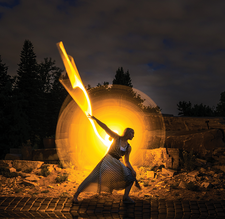Programmable light stick with the Raspberry Pi Pico
Painting with Light

© Photo by Xuan Nguyen on Unsplash
In the photographic method of light painting, you expose a subject over an extended period of time while moving the light sources. With a little technical support from a Raspberry Pi Pico, you can achieve sophisticated results.
Without light, nothing can be seen in photography, but with just a little background light and light brushes, you can create interesting motifs. For long exposures, you need a camera with manual adjustment and a tripod. A flashlight or laser pointer is sufficient to paint simple patterns or lettering into an on-going exposure. If you like to experiment, you might want to work with LEDs to achieve particularly interesting light graphics.
I was interested in a creative approach and in trying out what can be achieved with modern pixel elements and clever programming. The idea of a light stick for light painting was born. In this article, I use a Raspberry Pi Pico to build a MicroPython programmable LED light stick.
The control does not require much in the line of interfaces, and the hardware needs to be as compact as possible – a good fit for the Pico, which is the youngest member in the Raspberry Pi family and has already seen a huge amount of interest in the last months, with some interesting HATs to match. The large community proves to be a boon if you are looking for help. Currently the smallest Raspberry Pi model, the Pico comes with an RP2040 microcontroller chip and an ARM Cortex M0+ processor, offering a state-of-the-art alternative to comparable controllers. It can run C/C++ and performs well with MicroPython.
[...]
Buy this article as PDF
(incl. VAT)
